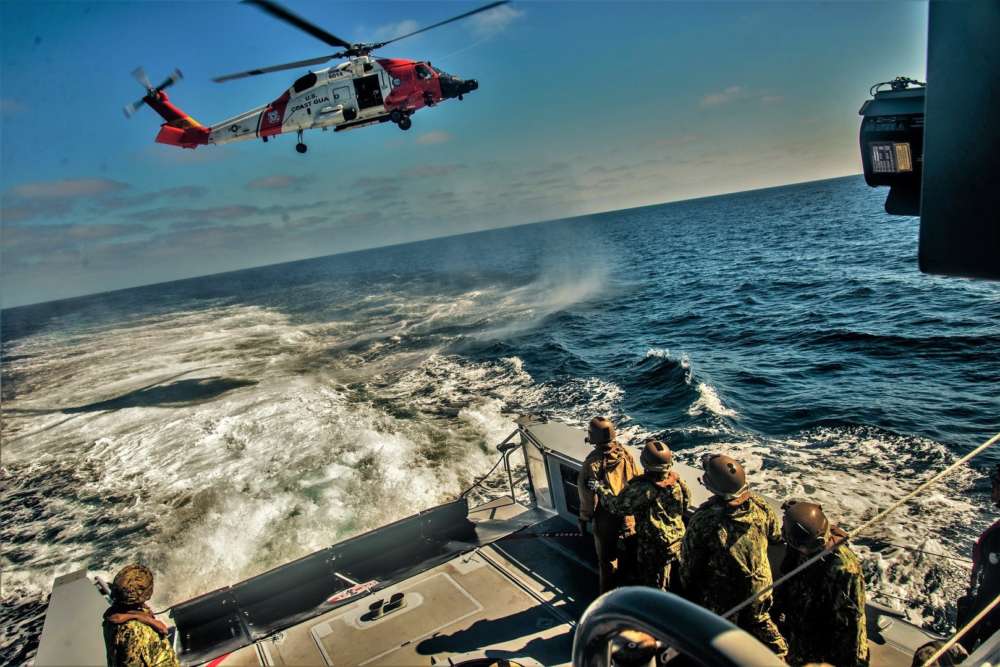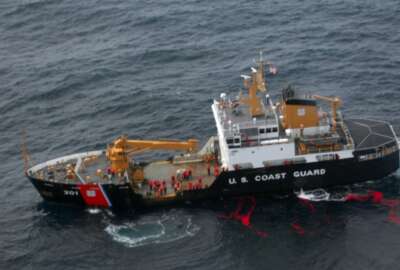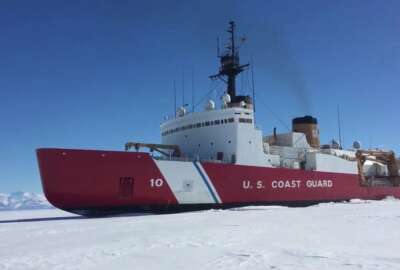
The Coast Guard joins the data generation
The Coast Guard recently joined scores of other agencies in appointing a chief data officer. More than that, in August it set up what it calls a "technical domain,"...
Best listening experience is on Chrome, Firefox or Safari. Subscribe to Federal Drive’s daily audio interviews on Apple Podcasts or PodcastOne.
The Coast Guard recently joined scores of other agencies in appointing a chief data officer. More than that, in August it set up what it calls a “technical domain,” centered on data and how to handle it. For details, the Federal Drive with Tom Temin spoke with that new Coast Guard CDO, Capt. Brian Erickson.
Interview transcript:
Tom Temin
All right, so let’s talk about the office. First, the Office of data and analytics is the setup just because everyone else has one and you figured you should have one too? Or do you have some real goals for it?Brian Erickson
Listen, some companies, I think set up their office of a chief data officer or an office of data analytics for defensive reasons. But the way I look at it, the Coast Guard, you know, really set this up for offensive reasons. So we recognized back in August of 2020, that the organization needed to become more data driven. And so at the time, the vice commandant signed the charter to charter a data readiness task force. And so for two years, the data array task force looked at lines of effort within the organization such as workforce development, data quality, the technical way ahead, data governance, and tried to figure out how we could as an organization change culture, processes, people and technology to become more data driven. And so the charter has said, you will stand down in two years and right on time, Sept. 1, we sunset, the data and his task force. And we stood up the office of data and analytics. And I’m really proud of the team to have completed that on time. And we’re just getting started and accelerating the advancement of data and artificial intelligence within the organization to really increase business efficiency and mission capability.Tom Temin
And where do you begin here? I mean, now there’s an office that has a stated mission? What do you do first?Brian Erickson
Along the way, along that journey, we knew that we needed to have a data strategy. So we started out with a data strategy, then we built a cloud adoption strategy, we knew that the technology had to move and advance in a different way, we determined that we needed a governance structure, some sort of a structure, who could focus specifically looking through the lens of data. So we stood up a data governance board that is chaired by my bosses, two flag officers that are high up in the organization with our deputy commandant for operations and our deputy commandant for mission support, then we stood up as kind of a subcommittee called the Data Governance Committee. And that is really the captain kind of senior civilian level made up of senior civilian level personnel from across the organization, all the business lines within the organization. And they’re able to identify the data challenges and tee that up for a data governance board to make recommendations and decision on, everybody had to be talking on the same language. So we made the first data lexicon so that we all were saying the same things, we knew what the terms meant. And then along the way, we needed an integrated data environment. While we were working this, we were in the middle of a COVID pandemic. And so we had contracted with some vendors to start up a couple of use cases specifically focused around managing COVID distribution of vaccinations first for the organization, but then also the vaccination status of our members. So we really got a chance to pilot integrated data and learn what we needed to do. And now we’re moving forward with standing up another environment like that.Tom Temin
I was going to say you need to have almost a specific use case to kind of focus things so that you gather the right data, so that you have something to have governance over and so on. Because if you think about, say, preventative maintenance of vessels, that’s a whole different problem and different bunch of data than something workforce related or something logistics related fair to say?Brian Erickson
Absolutely, Tom, we have so many different use cases that apply across all of our domains. So one way to break down the problem set is to identify individual domains, and we call them data domains. And luckily, within the Coast Guard, we can line those up with the business unit owner. So if you can imagine the CFO the chief financial officer is a business unit the chief engineer is a business unit under engineering and logistics, the deputy commandant for operations as the business unit for operations. We line the use cases up underneath these business units. And then often you’ll find that the data sources are very similar for conducting use cases within those particular domains. You want to have expertise such as data analysts, data stewards working within those domains, because they know what the data looks like, you know, when it goes in and they know what the data looks like, when it comes out of an analytic. And so, a lot of times when we have these use cases, we will go back to the product owner or the business owner who wants to conduct this use case and say what questions specifically are you trying to answer? Then we will try to figure out what analytic whether it’s a classical analytic or if you need to apply some artificial intelligence or something like that, some sort of advanced analytic. And that’s kind of how we approach different use cases.Tom Temin
We’re speaking with Capt. Brian Erickson. He’s chief data officer of the Coast Guard. And as the chief data officer, then what do you find most challenging is getting all the cats in order, or establishing what data you have and making sure that it’s where it needs to be.Brian Erickson
Yeah, Tom, I think that a lot of people would say that, you just need to buy some IT, some tech and all of your problems are solved. But that’s not exactly what we’re seeing, what we see is that the biggest steps forward for us are going to be in people and culture, the organization has been around since 1790, we have a certain way of doing business. You know, we have partner agencies that we work with and priorities of, you know, one agency may not be the exact priority of another agency. So often we find that there’s a lot of communication, there’s a lot of partnership activity that needs to occur in order for us to move forward with elements of data management, such as data sharing, data quality, data stewardship and ownership. So I would say that those are the areas that we are focusing on the most to change within the organization.Tom Temin
And what is your data strategy? There must be I mean, you do have to have some technical base in order to have the data somewhere? And is that just simply in a logical arrangement? It lays where it lays for applications now? Or is there a separate data store that you are replicating data sets in for purposes of analytics?Brian Erickson
Yeah. So on the technical side, we have what we would call source systems that are siloed systems around the organization or with partner agencies, for which datasets exist that we want to have access to. As we bring in these datasets to a central location that we call an integrated data environment, you can start to relate these different datasets through, you know, relational databases and unique identifiers, to where as you combine the data sets, you can gather insights that you were never able to before. And so I think the strategy from a technology perspective is to have a technology stack that allows a workspace that allows analysts to have a sandbox to innovate within to find insights at speed, you know, so we want to be able to have data almost in like you, like you had pointed out a marketplace view to where data analysts can grab the datasets that they want, bring them into their exploratory environment, provide insights for mission managers, and leaders, and then rinse and repeat. And that really doesn’t exist within the organization right now. And that’s one of the things that we’re working on standing up about just a couple of months ago, we awarded a contract for our first ever Coast Guard data catalog and data governance tool set. And this will allow us to provide visibility of critical datasets within the organization like we have never had before, and also share those datasets with partners within DHS and DoD.Tom Temin
And as you move into 2023, and this gets funded, presumably we’ll have appropriations at some point. What are your metrics for, say, the first year’s success? How will you know that the whole endeavor is bringing what the Coast Guard hopes it’ll bring?Brian Erickson
We want to have very specific metrics for measures of success. Right now, our metric of success is onboarding users within this environment that I’m describing the ability to provide capability from our integrated data environment that we’re standing up. As an example, we are working on an aviation readiness tool that would allow aviation operators at air stations, pilots and aircrew to better understand their individual proficiency, understand the proficiency of the unit as a whole and provide kind of a visualization for senior leaders to get a sense on what is our readiness of our personnel right now. As that expands, it will expand across other units such as small boats, cutters, and move across the Coast Guard so that we can get a sense of all of our readiness, we want to have a full 360 degree view of our people. And we have the data available. We just don’t have it integrated in an area where we can start to show those metrics. So I would say the metrics that we really want is to be able to describe our people and view our people within the organization. It’s really at the descriptive analytics level right now.Tom Temin
Sure, I guess nothing can really happen until you identify the talent base to make it happen.Brian Erickson
Yeah, absolutely. And for a long time, and as long as I have been in we recognize that data analytics or operations research is important for the organization, the Coast Guard Academy has a major, which is an operations research data analytics major. And that has been around since I have been in the organization, since I went to the academy. But we need more than that, we need to train on modern tool sets, we need to train on modern practices falling in line with DoD, we are looking at the innovation roles such as artificial intelligence practitioner, data engineer, data scientist, and we are looking to see where in the organization we need to place those personnel in order to extract the maximum amount of value from our data.Tom Temin
So you’ve got a lot of work to do.Brian Erickson
There is opportunity everywhere, Tom, and I’ve got a great team. And again, we are hiring right now. There is a lot of opportunity to serve within the Coast Guard. And one of those areas right now is this innovative office of the Office of Data Analytics. We are hiring data scientists, data governance experts, as well as technology manager, so let your friends know.
Copyright © 2025 Federal News Network. All rights reserved. This website is not intended for users located within the European Economic Area.
Tom Temin is host of the Federal Drive and has been providing insight on federal technology and management issues for more than 30 years.
Follow @tteminWFED
Related Stories

GAO: Coast Guard too slow creating rules to improve safety aboard older commercial fishing vessels




